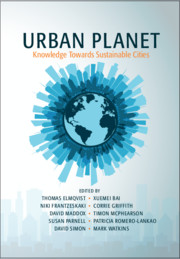Pursuing any vision of a thriving, agile city of the future requires grappling with a foe as ineluctable as gravity. That foe is inertia. It comes in two main varieties – infrastructural and societal. To convey what I mean, I’ll start with two moments from New York City Mayor Michael Bloomberg’s final term in office. In a 2013 report, his sustainability team featured this sobering finding: “Energy use in buildings accounts for 75 percent of New York City’s greenhouse gas emissions, and 80 percent of the buildings that will exist in 2050 are already here today.”Footnote 1
I hope you’ll stop and read that twice, slowly absorbing each word’s meaning in the context of what you’ve heard about grand visions for a rapid global transition to low-carbon societies in places for rich and poor. In older cities, a lot of what has to come is the kind of grinding door-to-door, boiler-by-boiler effort that isn’t well conveyed in shiny architectural renderings. An analyst in Mayor Bill de Blasio’s sustainability office told me in 2016 that, on closer look, 90 percent of 2050’s buildings exist today.)
That’s infrastructural inertia. It’s arguably a tougher enemy to overcome than fossil fuel lobbyists.
Then there’s societal inertia, much of which springs from basic reflexes embedded deep in human consciousness and is shaped by many of our social institutions, such as politics. People tend to overvalue the present, the familiar and proximal, while hyperbolically discounting future risks or hazards that are rare and unpredictable. This trait has served us well, so far. It’s no wonder elected officials mostly lead from behind, too often offering voters pothole repairs more than new commuter trains.
I don’t mean to pick on former Mayor Bloomberg, who in fact has been a tireless champion of action on climate change. But his final big speech on the subject as mayor, laying out plans for investing $20 billion by mid-century in making his city resilient, centered on a core theme that illustrates the potent pull of the status quo.
In the face of solid science pointing to centuries of sea-level rise ahead even with action to slow global warming, he said, “[A]s New Yorkers, we cannot and will not abandon our waterfront. It’s one of our greatest assets. We must protect it, not retreat from it.”Footnote 2
It’s easy to point a finger, but when talking to young people about climate change, I challenge them to pretend they’re the press secretary to a mayor of a coastal city and tasked with writing an effective speech proclaiming, “We will retreat.” I’ve tried many iterations myself and haven’t come up with a formulation yet that any mayor would embrace.
I also challenge young people to invent a new relationship with climate change and its impacts – working for the long haul to blunt warming, but moving beyond a defensive posture and embracing the design opportunities faced in a world with, among other novel features, no new normal coastline for centuries to come.
This all might sound insurmountably daunting, but I’ve seen bright possibilities, often involving innovations in education and communication. When she was director of sustainability for the New York City Department of Education, Ozgem Ornektekin oversaw a retrofitting program for heating and cooling systems in hundreds of buildings. After discussions with the city’s unions, she and others realized there weren’t enough skilled building technicians in the city to manage the new technology. So she pursued the creation of the High School for Energy and Technology in the Bronx to teach the skills needed to fill those jobs. Students there now routinely tour the boiler room (which ran on hand-shoveled coal just 20 years ago!) as part of their curriculum, learning about the school as a system, not just a collection of classrooms.
Imagine the potential for spreading smarter energy choices if every school had a boiler room tour.
As for the challenge of re-envisioning coastal cities in a world with (essentially) endlessly rising seas, compromise will be essential. Geographer Peirce Lewis’s description of New Orleans as both impossible and inevitable will increasingly apply to a host of metropolises around the world (Peirce Reference Peirce2013). In such instances, a managed (and politically tenable) retreat can be sold, as already has been the case in New York.
With federal funding and widespread support, New York City is taking the first steps by adopting the East Side Coastal Resiliency Project, which is seen as the first phase of a larger Dryline project – a buffer against storm surges that also serves as a public recreational and green corridor, designed by the Danish architectural firm Bjarke Ingels Group, with city involvement.
A day will come, perhaps not until well into the twenty-second century, when this defense will slide beneath the waves, given the inertia in the climate system and erosion of polar ice sheets.
But this is how the urban environment will evolve in the Anthropocene – Earth’s Age of Us – step by imperfect step, learning and adjusting, testing and faltering, then testing again, impossibly and inevitably.



